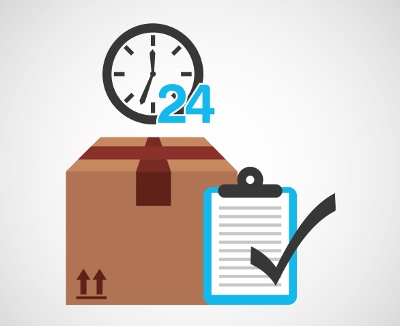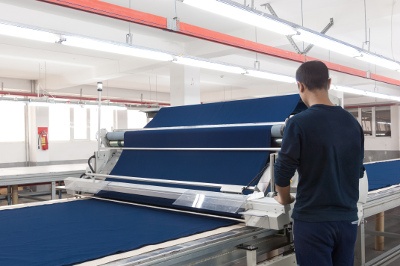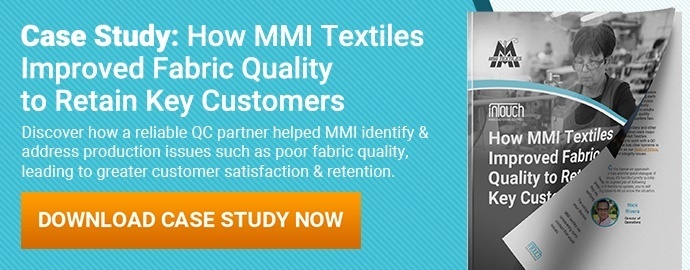 Imagine hiring a third-party inspection team to check an order of fabrics you’re importing from a factory in India. A lot can go wrong. Factory staff might bribe your inspectors in exchange for omitting serious quality issues from their report. You might struggle to communicate your requirements with the inspection team. And you could waste precious days waiting to receive the finished inspection report, which could cause shipping delays as you try to address issues from the report with your supplier.
Imagine hiring a third-party inspection team to check an order of fabrics you’re importing from a factory in India. A lot can go wrong. Factory staff might bribe your inspectors in exchange for omitting serious quality issues from their report. You might struggle to communicate your requirements with the inspection team. And you could waste precious days waiting to receive the finished inspection report, which could cause shipping delays as you try to address issues from the report with your supplier.
Pre-shipment inspection by a professional third party is many importers’ last line of defense against quality defects and other problems. In fact, third-party inspection has helped many fabric importers manage and even improve product quality over time (related: How MMI Improved Fabric Quality to Retain Key Customers [Case Study]).
But with the influx of many different companies offering third-party inspection services in recent years, knowing how to choose the right QC provider can be a challenge. So let’s break down the top five traits experienced importers look for in a third-party fabric inspection provider.
1. High integrity practices by inspectors
Inspectors often work in close quarters with factory staff when conducting inspections. It’s natural for them to exchange pleasantries and chat during the course of an inspection, which can span several hours. But this also means there are ample opportunities for underhanded activity to occur between inspectors and factory staff.
Bribery, or any overt exchange of money between factory staff and the inspector, is one of the most obvious ways an inspector’s integrity can be compromised (related: Top 5 Issues that Can Affect QC Auditor Integrity). But subtler benefits like transportation, meals, gifts, accommodation and entertainment provided or arranged by factory staff can also affect your inspector’s integrity in several ways, such as:
- Outright false reporting of fabric quality: misrepresenting the quantity or severity of defects found or the results of on-site testing
- Under-inspecting: inspecting a smaller sample size than agreed-upon
- Overstating the quantity of finished goods to make it appear as if the factory’s production is on schedule
- Hiding factory information, like factory location, conditions and use of sub-suppliers
- Leaking of the customer’s proprietary information
The most common immediate impact of such integrity problems is inaccurate reporting, which can lead you to make misinformed shipping decisions and receive goods that don’t meet your requirements. But more serious consequences, such as intellectual property (IP) theft or social compliance violations, can also happen.
What does high integrity look like in a third-party inspection firm?
Trying to spot potential integrity problems with a QC provider before you’ve started working with them can be tricky. It’s especially difficult for importers that haven’t faced integrity breaches before to know what preventative measures to look for. But there are a few specific practices or prevention methods you can ask a potential QC provider about, including:
- Do inspectors have a clear Code of Ethics to follow with serious repercussions in place for misconduct? A Code of Ethics should maintain the inspection company’s independence from its clients and their clients’ suppliers.
- Do inspectors have an established procedure for handling and reporting any incidents related to integrity? For example, some companies have what’s called a “factory integrity declaration form", which inspectors and supplier representatives sign following the inspection to acknowledge any benefits inspectors might have received from the supplier (e.g. transportation, meals, gifts, etc.).
- Does the QC provider take other steps to prevent integrity problems? These could vary from rotating inspectors regularly to prevent overly friendly relationships between inspection and factory staff to internally auditing inspection staff periodically to verify there’s no misconduct during the service.
You won’t always be able to see proof that a third-party QC provider takes reasonable measures against corruption. But staff should at least be able to explain what procedures they have in place to prevent integrity problems. And answers to these questions will help you determine if you’re working with an inspection team that values high integrity.
2. Reliable communication through a single point of contact
If you’re like many fabric importers, you’re likely juggling communication with suppliers, freight forwarders, customers, your own internal staff and other parties. You probably don’t need or want to speak with several different contacts at a third-party inspection company just to arrange inspection.
Instead, it’s usually helpful to have a single, dedicated person that can serve as your main contact, communicating with you directly while coordinating your inspection “behind the scenes”. That’s why reliable communication through a single point of contact is a trait fabric importers typically value in a third-party QC provider.
How to spot reliable communication in your contact person
Being able to contact the same person each time you have questions or needs related to inspection can simplify your business and prevent headaches. But there’s more to reliable communication than just being able to call on a single contact. There are a few criteria this person should meet to be effective:
- Proficient ability in English and the local language. Your contact should be able to converse well with you and with your local vendor or factory contact.
- Western education or training. Miscommunication with your supplier can often result from cultural differences. Communicating through a dedicated contact that is familiar with both Western and local culture and business practices can help you avoid confusion (related: Why You Can’t Assume Chinese Suppliers Always Understand Requirements).
- Availability by email, Skype and phone. If you or your supplier can’t easily reach your QC contact reliably, you’re likely to find scheduling inspection and receiving clear results difficult.
- Swift response. The situation at your supplier’s factory can change quickly. And your contact should generally be responsive to any inquiries within 24 hours. This will help you clarify or resolve issues as soon as possible to prevent delays.
A professional third party can often help you streamline your communication with your supplier. But remember that your supplier is not working for your independent inspection firm. You still need to follow up with your supplier contact regarding shipping deadlines and next steps after inspection (related: Why QC Inspectors Rarely Work with Chinese Factory Staff to Fix Issues).
3. Fast reporting following fabric inspection
Receiving inspection results quickly may not seem like a top priority for many fabric importers. But if inspection reveals problems with your product, knowing about these as soon as possible will help you address them without causing delays (related: 4 Ways to Address Product Defects Found During QC Inspection). This is especially true with final inspection when 80 percent or more of a shipment is already completed in the factory.
The inspection report is basically your only reliable insight into the status and quality of your goods. With the report in hand, you can determine if your products are ready for shipping, or if the factory needs to conduct corrective action like product rework first (related: What QC Inspection Results Do and Don’t Mean for Your Shipment).
Problems caused by slow reporting
A lot can go wrong if you have to wait several days to receive an inspection report. Seeing inspection results may not be very helpful if you receive the report late and need to ship the order immediately. You might be forced to choose between accepting defects in your goods and missing your delivery deadlines—both undesirable options that can upset customers.
Faster reporting allows you plenty of lead time if factory staff must conduct product rework or repairs on the order. Workers can actually introduce new defects to your products if they to rush this process due to late notice from you.
Most third parties that offer textile inspection services should be able to issue their full report within 24 hours of inspection. Many companies can even issue you their report within just a couple hours of completing the inspection, allowing you to follow up with your supplier that same day about any issues found.
But what good is a fast report if it doesn’t include all of the information you need to make an informed decision regarding fabric quality? That brings us to our next point.
4. Detailed reporting of fabric inspection procedure and results
Comprehensive reporting is a must for fabric importers who are relying on third-party inspection companies to be their “eyes and ears” in the factory. But inspection reports can vary across the QC industry with regard to their organization and the information they provide the importer.
A comprehensive report should include not only details related to the importer’s provided specifications, but also any potential issues regarding packaging and fabric quality outside of the importer’s requirements. Professional fabric inspectors typically have years of experience with assessing fabric quality and should be familiar with common quality issues for fabric. They can often point to issues you may not have considered looking for.
What to expect in your fabric inspection report
There are several important parts that professional QC staff include in most inspection reports, regardless of product type. Your fabric inspection report should generally include all of the following:
- Total quantity of finished and packed fabric found at the factory, typically expressed in rolls per SKU and/or total length of fabric in yards or meters
- Number and type of defects found in inspected units, including holes, tears, discoloration, stitching issues and other imperfections
- Any nonconformance to provided specifications, such as deviations in fabric shading, roll core thickness or labeling
- Results of any on-site testing, such as fiber content testing, fabric density check and breaking strength testing
- Any issues or unexpected situations that hindered the inspection, such as disputes with factory staff or refusal of factory staff to allow specific tests
- Photos of inspected fabrics, packaging, test results and any defects or other findings
 Photos of findings can be very helpful in determining the severity of any issues found, especially where written remarks may not be descriptive enough. They also provide you with assurance that inspectors performed any on-site testing as you required.
Photos of findings can be very helpful in determining the severity of any issues found, especially where written remarks may not be descriptive enough. They also provide you with assurance that inspectors performed any on-site testing as you required.
Reports should also provide information regarding the sampling method and defect classifications used to arrive at a clear inspection result. For bulk textiles, inspectors will typically use the industry-standard 4-point system to assign appropriate “penalty points” for each defect found within a section of fabric. For other textile products, the industry-standard AQL system provides clear tolerances for defects in a sample (related: The Importer’s Guide to Managing Product Quality with AQL [eBook]).
When you might receive a “pending” inspection result
A simple “pass” or “fail” inspection result is desirable and common in most cases. But sometimes an unexpected issue can arise during inspection that leads to an overall “pending” result in the report.
For example, perhaps the inspector noticed labels on polybags didn’t include a lot number. Or maybe the factory didn’t provide the equipment needed for infrared readings testing. These are potential issues omitted from specifications or inspection criteria that the inspector felt might affect your decision to ship the goods.
Though it might seem frustrating to receive an inconclusive pending result, you should value such transparency on the part of your inspector. It would be easy for a third-party inspection company to simply ignore any nonconformances you didn’t include and issue a passing result. But by seeing these potential problems in your report, you’re empowered to decide whether they should actually affect shipping.
5. Supplementary QC services for fabric importers
Product inspection occupies a relatively small space in most fabric importers’ supply chain. And a company that only offers inspection services may have a somewhat limited perspective of your manufacturing challenges.
For example, you might also be struggling with meeting brand or retailer compliance standards. And garment and fabric importers are especially under pressure to monitor social compliance in their suppliers’ factories. A third-party QC provider that also offers auditing services can help you assess and meet compliance as well as inspect and report on your fabric quality.
Services that complement inspection for fabric importers
Some inspection companies provide not only textile inspection services but also other supplementary services, such as:
- Social compliance pre-audits in accordance with retailer frameworks or international standards like SA8000.
- Supplier reviews to evaluate supplier facilities, typically during the sourcing process. These audits often focus on a factory’s quality management systems (QMS) and are based on ISO9001 standards.
- Supplier identification and product sourcing.
- Lab testing for by certified laboratories, typically to verify material composition or other properties.
When you use the same company for multiple services, staff at the company typically have a better understanding of your product type and manufacturing needs from past services.
Some companies may claim to have experience in services when they’ve rarely ever actually provided them for a fabric importer. It’s always a good idea to verify a company’s credentials, certifications and ask for references.
Conclusion
Third-party inspection is often a better option for fabric importers than relying on factory QC staff or personally traveling to factories to inspect (related: 4 Ways Importers Conduct Product Inspections [eBook]). But that’s true only if you’re working with an experienced company that is well-trained in QC procedures and qualified to inspect your textiles.
Sift through the less qualified QC companies and look for these five traits in your chosen QC provider. A QC partner that encompasses all five traits is sure to guide you through a smoother manufacturing experience.
What other qualities do you look for in a third-party fabric inspection partner? Share in the comments section below!







